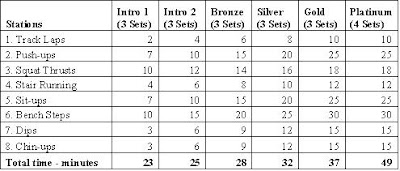The Unofficial Guide to the Hart House Circuit
"The circuit training programme was designed in 1953 by Professor Emeritus Kirk Wipper (University of Toronto). At the time it was developed, the circuit training programme bridged a significant demand for individual fitness development. Today, as in the past, Professor Wipper's efforts are inspiring generations of Hart House members to achieve a better fitness level and a healthier lifestyle." -Hart House Circuit Training Handbook
The following chart shows the stages of the Hart House Circuit. This is taken from the plaque posted near the Hart House Track.
The following chart shows the stages of the Hart House Circuit. This is taken from the plaque posted near the Hart House Track.

- Perform each exercise (1-8) sequentially, and repeat for 3-4 sets (depending on level).
- Beginning with Intro I, progress to the next level once all three sets can be completed easily within the minimum time (i.e. for Intro I, minimum completion time is 23 minutes).
- Weekly participation is recommended (Hart House Circuit Training Handbook recommends 3 times weekly)
Personal Notes on Exercises:
- Track Laps: The Hart House track is approximately 143 m (7 laps = 1 km).
- Push-ups: My personal recommendation is to go all the way down, with the chest just touching the ground
- Squat thrusts: In my training with the Iron Dragons (University of Toronto Engineering Dragonboat Team), these are substituted with burpees, which are identical to squat thrusts, but jumping instead of just standing.
- Stair Running: These are performed without skipping any steps. One "rep" is 22 steps on the Hart House Circuit.
- Sit-ups: Try to not use momentum and use full range of motion, with your shoulder blades touching the mat when you are down, and your elbows to your knees when you come up.
- Bench Steps: These should be performed with the legs, with the force mainly coming from the leading leg. Maintain an upright posture and avoid swinging at your hips / back to assist with the movement.
- Dips: Again, full range of motion :)
- Chin-ups: Full range of motion = chin above the bar (or chest to the bar for those more ambitious), and full dead hang. It is important to control your movement on your way down to mitigate undue stress to your shoulders and elbows when you return to the dead hang position. Note that chin-ups use palms facing and pull-ups are palms away. Either variation is acceptable and variation is encouraged for more complete muscle development.
Final Thoughts
- Post: You're encouraged to post your level and time on this blog (through comments). You can see how you progress over time and encourage others in their pursuit of fitness.
- Substitutions: There are alternative substitutions for various exercises. You are encouraged to substitute exercises to increase difficulty, add variation, and to reduce injury.
- Have fun and smile!
Comments
Question never occured to me till I did Intro 1 the other day.
Josh, perhaps you can add the locations of where to do all the exercises - the chin-up corner and the middle are both places where you can do these exercises however, where you do them will affect your time.
Starting the run at the chin-up bars and finishing by the stairs shortens the run by ~25 m, but at the higher levels (where the run is about 1 km) that's really not a significant difference.
Damian, ultimately what matters is consistency, which makes times comparable. There's no actual fitness benefit in doing things in different locations to get a slightly lower time.
Re: Bench Steps
- According to the Circuit Training Handbook, the number of reps can be done on either leg. They recommend switching halfway through the set.
- In this case, Damian would be doing twice as many of the prescribed reps - whoa!
Re: Location
- I agree to a large extent with Paul, that consistency is key.
- Personally, I do the first half in the matted area and the second half in the far corner. I do this each time and run the extra half lap.
In my opinion, at the end of the day, the most important thing is technique. It's particularly difficult to execute proper technique in the latter reps when you're very tired (i.e. complete range of motion pull-ups on your last set).
Do it one way. Do it with integrity. Do it consistently. And you'll be okay :)
And have fun!
1 rep is going down and up the flight of stairs (the "V"). ~22 steps in one direction; or ~10 steps up and down. It would be as you have described.
Cheers